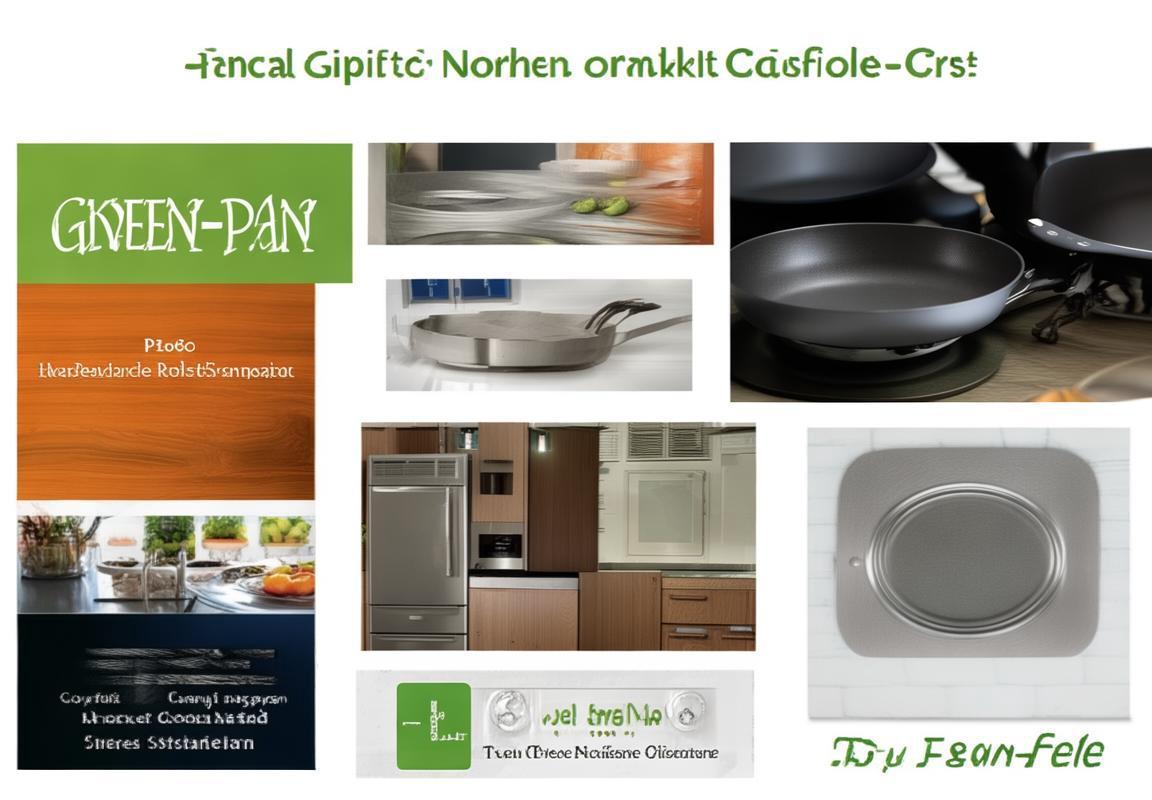In the ever-evolving landscape of kitchen appliances, ceramic coated non-stick plates have emerged as a standout innovation. These cookware items, known for their durability and non-toxic properties, have captured the interest of consumers across the globe, particularly in Europe and the United States. This article delves into the reasons behind the growing popularity of ceramic coated non-stick plates, the impact of their production on the market, and the insights into consumer preferences and market segmentation that shape this burgeoning industry. As we explore the future prospects and case studies of successful brands, it becomes clear that ceramic coated non-stick plates are not just a trend; they are shaping the future of kitchenware.
Introduction to Ceramic Coated Non-Stick Plates
Ceramic coated non-stick plates have emerged as a game-changer in the kitchenware industry, offering a healthier and more durable alternative to traditional non-stick coatings. These innovative plates are a blend of form and function, designed to enhance the cooking experience while ensuring ease of use and maintenance. Let’s delve into the world of ceramic coated non-stick plates and understand what makes them stand out.
Manufactured with a ceramic coating, these plates are not only attractive but also highly functional. The ceramic coating process involves applying a thin, durable layer of ceramic to the surface of the cookware. This layer provides a non-stick surface that is free from harmful chemicals like PFOA and PTFE, which are commonly found in older non-stick coatings.
The non-stick properties of ceramic coated plates are superior to those of traditional non-stick coatings. The ceramic material has a unique structure that creates a smooth, easy-to-clean surface. Foods release from the plate effortlessly, reducing the need for excessive oil or butter. This makes cooking healthier and more efficient, as it cuts down on calories and fat.
One of the standout features of ceramic coated non-stick plates is their durability. The ceramic layer is much harder than traditional non-stick coatings, which means it can withstand scratching and wear and tear better. This longevity makes ceramic coated plates a cost-effective choice in the long run, as they are less likely to need replacement compared to other types of cookware.
In the kitchen, the ease of cleaning is a top priority. Ceramic coated plates are designed to be exceptionally easy to clean. Since food particles do not stick to the surface, you can often wipe them clean with a damp cloth or sponge. For more stubborn stains, a mild detergent and water will do the trick. This not only saves time but also reduces the amount of elbow grease needed to maintain your cookware.
The aesthetic appeal of ceramic coated non-stick plates is another factor that contributes to their popularity. These plates come in a variety of colors and designs, allowing consumers to choose cookware that complements their kitchen decor. The sleek, modern look of ceramic coated plates also adds a touch of sophistication to any kitchen space.
As we look at the European and American markets, we see a growing demand for ceramic coated non-stick plates. Health-conscious consumers are increasingly seeking out cookware that aligns with their values, and ceramic coatings offer a solution that is both non-toxic and sustainable. The market for ceramic coated cookware is expanding rapidly, driven by factors such as rising health awareness, environmental concerns, and the desire for high-quality, durable products.
The rise of ceramic coated non-stick plates has also been fueled by the efforts of various manufacturers who have invested in research and development to improve the technology. These companies are not only focused on the non-stick properties of the plates but also on enhancing their thermal conductivity, ensuring even heat distribution for perfect cooking results.
The environmental aspect of ceramic coated plates cannot be overlooked. The use of eco-friendly materials and the reduction in chemical emissions during the manufacturing process make these plates a greener option. As consumers become more environmentally conscious, they are more likely to choose cookware that reflects their commitment to sustainability.
In conclusion, ceramic coated non-stick plates are a testament to the ever-evolving kitchenware industry. They offer a host of benefits, from health and safety to durability and aesthetic appeal. As the demand for these plates continues to grow, we can expect to see further innovation and advancements in the technology, making them an even more attractive option for consumers around the world.

Market Dynamics in the European and American Kitchen Appliances Industry
The European and American kitchen appliances industry is a bustling marketplace, characterized by rapid technological advancements, evolving consumer preferences, and a strong emphasis on sustainability. This dynamic landscape is shaped by a variety of factors, from the latest innovations to shifting demographic trends.
In Europe, the kitchen appliances market is known for its sophistication and innovation. Consumers here are not just looking for practical solutions but also for products that enhance their lifestyle. Smart appliances, which offer connectivity and integration with other devices, are increasingly popular. Brands are responding by developing kitchen tech that not only performs well but also aligns with the European ethos of quality and design.
On the other side of the Atlantic, the American kitchen appliances market is vast and diverse. It’s marked by a strong focus on convenience and efficiency. American consumers are always on the lookout for the latest gadgets that can simplify their cooking routines. The market is also influenced by the rise of health-conscious cooking, with an increasing number of appliances designed for baking, roasting, and cooking at precise temperatures.
The European market is seeing a surge in demand for eco-friendly appliances. With the continent’s commitment to reducing carbon footprints, there’s a growing preference for energy-efficient and recyclable kitchen products. The demand for ceramic-coated non-stick cookware, for instance, is on the rise due to its non-toxic nature and eco-friendly production process.
In the U.S., the market is more segmented, with a variety of product categories and price points. The mid-to-high-end segment is particularly competitive, with consumers willing to invest in premium appliances for their durability and performance. This segment includes high-tech features like induction cooking, steam ovens, and air fryers, which are becoming more mainstream.
The kitchen appliances industry in both regions is also heavily influenced by retail channels. Online sales are on the rise, driven by the convenience of shopping from home and the ability to compare prices and read reviews. However, traditional brick-and-mortar stores still play a significant role, especially in the sale of premium appliances where consumers value the hands-on experience and expert advice.
One cannot overlook the impact of globalization on the European and American kitchen appliances industry. Brands from around the world are vying for market share, bringing with them new technologies and design aesthetics. This competition fosters innovation and drives down prices, benefiting consumers.
In Europe, the market is also affected by regulatory changes. New safety standards and energy efficiency regulations are constantly being introduced, which can impact the design and production of kitchen appliances. Compliance with these regulations is not only a legal requirement but also a key factor in consumer trust.
In the U.S., the industry is influenced by the country’s diverse cultural landscape. Different regions have their own preferences, from the rustic charm of Southern cooking to the bold flavors of New York cuisine. This diversity means that kitchen appliance manufacturers must cater to a wide range of culinary styles and needs.
The European and American kitchen appliances industry is also characterized by a strong focus on service and after-sales support. Brands that offer comprehensive warranties, customer service hotlines, and easy-to-access repair services are often favored by consumers.
In conclusion, the market dynamics in the European and American kitchen appliances industry are complex and multifaceted. They are driven by consumer demands for innovation, sustainability, and convenience, as well as by the global trend of technology integration. As the industry continues to evolve, it will be interesting to see how these factors shape the future of kitchen appliances in both regions.

The Rise of Ceramic Coated Non-Stick Plates
The ceramic coated non-stick plates have emerged as a game-changer in the kitchen appliances industry, gaining significant popularity in recent years. This surge in demand can be attributed to several factors that have reshaped consumer preferences and market trends.
-
Health and Safety Concerns: With the increasing awareness of the health risks associated with traditional non-stick coatings, which contain PFOA and PTFE, consumers are turning to alternative options. Ceramic coatings, being free from these harmful substances, offer a safer choice for cooking enthusiasts.
-
Enhanced Performance: Ceramic coatings provide superior non-stick properties compared to their traditional counterparts. The smooth, hard surface of ceramic-coated plates allows for effortless food release, reducing the need for excessive oil or butter, and making cooking a breeze.
-
Durability and Longevity: One of the standout features of ceramic coated non-stick plates is their exceptional durability. These coatings are resistant to scratches, stains, and fading, ensuring that the plates maintain their performance and appearance over time. This longevity is a major draw for consumers who value investment pieces for their kitchen.
-
Eco-Friendly Appeal: As environmental concerns grow, consumers are seeking products that align with sustainable practices. Ceramic coated non-stick plates are environmentally friendly, as they can be washed with mild soap and water, avoiding the use of harsh chemicals that can contaminate water sources.
-
Versatility in Cooking: These plates are not limited to a single type of cooking. Whether it’s sautéing, frying, or baking, ceramic coatings provide a versatile surface that can handle various cooking techniques. This adaptability makes them a favorite among chefs and home cooks alike.
-
Style and Design: Ceramic coated non-stick plates come in a variety of colors and patterns, adding a touch of style to any kitchen. The sleek, modern look of these plates complements contemporary kitchen designs, making them not just a functional choice but also a statement piece.
-
Consumer Trust and Brand Recognition: Several well-known brands have embraced ceramic coatings, further solidifying their trustworthiness in the market. As these brands continue to innovate and improve their products, consumer confidence in ceramic coated non-stick plates has grown.
-
Market Expansion: The rise of ceramic coated non-stick plates has also been fueled by the expansion of global markets. As these products gain traction in Europe and the United States, they are also making their way into emerging markets, where the demand for high-quality, safe cookware is on the rise.
-
Technological Advancements: Continuous advancements in ceramic coating technology have contributed to the popularity of these plates. Innovations such as thicker coatings, improved heat resistance, and enhanced scratch resistance have made ceramic coated non-stick plates even more appealing to consumers.
-
Social Media and Influencer Endorsements: The power of social media and influencer endorsements cannot be overstated. As influencers share their positive experiences with ceramic coated non-stick plates, more consumers are becoming aware of the benefits and are more likely to make the switch.
In conclusion, the rise of ceramic coated non-stick plates in the kitchen appliances industry is a testament to the evolving consumer mindset, with a focus on health, performance, sustainability, and aesthetics. As these plates continue to gain momentum, it’s clear that they are here to stay, reshaping the way we cook and the products we choose for our kitchens.

Why European and American Consumers are Embracing Ceramic Coating Technology
European and American consumers have been increasingly drawn to ceramic coating technology for their cookware. This shift is driven by a combination of factors that resonate with their values and lifestyle choices. Here’s a closer look at why this technology is gaining such traction:
-
Health and Safety ConcernsConsumers in Europe and the US are more health-conscious than ever before. Traditional non-stick cookware often contains PFOA (perfluorooctanoic acid) and PTFE (polytetrafluoroethylene), which have been linked to health issues when overheated. Ceramic coatings, on the other hand, are free from these harmful chemicals, offering a safer cooking experience. The peace of mind that comes with knowing their food isn’t being exposed to potentially toxic substances is a significant draw for many consumers.
-
Environmental ConsiderationsThe growing environmental movement has influenced consumer choices in the kitchen. Ceramic coated non-stick plates are typically more durable than their traditional counterparts, which means they last longer and reduce the need for frequent replacements. This longevity is not only cost-effective but also environmentally friendly, as it cuts down on waste and the energy required for manufacturing new products.
-
Non-Toxicity and Eco-Friendly ProductionCeramic coatings are derived from natural minerals, making them a more eco-conscious choice. The production process for ceramic coated cookware is generally more sustainable than that of traditional non-stick coatings. This aligns with the values of European and American consumers who are increasingly looking for products that are produced with minimal environmental impact.
-
Enhanced PerformanceCeramic coatings offer superior non-stick properties compared to traditional coatings. They maintain their non-stick quality even after frequent use and high-heat cooking, which is a significant advantage for busy cooks who don’t want to worry about food sticking or the need for excessive oil. This performance boost has made ceramic coated non-stick plates a preferred choice among consumers who value efficiency and convenience.
-
Aesthetic AppealThe sleek, modern look of ceramic coated cookware is also a draw for consumers. The glossy, smooth surface of ceramic coatings adds a touch of elegance to kitchen countertops, appealing to those who are looking to enhance the aesthetic of their cooking spaces. The variety of colors and finishes available also allows consumers to express their personal style.
-
Durability and Easy CleaningCeramic coatings are known for their durability, which means they can withstand scratches and wear better than many other cookware materials. This durability is complemented by the ease of cleaning, as food particles often slide off the surface without the need for scrubbing. This combination of longevity and low maintenance is highly appealing to consumers who want cookware that will last and require minimal effort to keep clean.
-
Healthier CookingThe non-stick nature of ceramic coatings allows for healthier cooking methods, such as sautéing and stir-frying with less oil. This is particularly appealing to health-conscious consumers who are looking for ways to reduce their fat intake and prepare meals that are both nutritious and delicious.
-
Global Recognition and Brand TrustAs ceramic coated non-stick plates have gained popularity, several reputable brands have emerged, offering high-quality products that are trusted by consumers. The global recognition of these brands has further influenced consumer preferences, as they associate the ceramic coating technology with reliability and quality.
-
Technological AdvancementsThe continuous advancements in ceramic coating technology have also played a role in its rise. Innovations such as reinforced ceramic coatings that offer even better non-stick performance and increased durability have made these plates even more appealing to consumers who are looking for the latest in cookware technology.
-
Lifestyle IntegrationThe integration of ceramic coated non-stick plates into various aspects of daily life is another reason for their popularity. They are not just a kitchen tool but a part of a lifestyle that emphasizes health, sustainability, and convenience. This holistic approach to cooking and living resonates with many European and American consumers who are seeking to align their purchasing decisions with their lifestyle goals.
In summary, the embrace of ceramic coating technology by European and American consumers is a multifaceted phenomenon, driven by a desire for healthier, more sustainable, and efficient cooking solutions. The combination of these factors has created a strong market for ceramic coated non-stick plates, and it’s likely that this trend will continue to grow as more consumers become aware of the benefits these products offer.

The Impact of the Ceramic Coated Non-Stick Plates Factory on the Market
The surge in demand for ceramic coated non-stick plates has been nothing short of remarkable, and the factories that produce these innovative cookware items are playing a pivotal role in shaping the market landscape. These factories, often located in regions with a strong manufacturing base, are not just churning out products; they are revolutionizing the way consumers perceive and use non-stick cookware.
These factories have become hubs of innovation, investing heavily in research and development to improve the quality and durability of their ceramic coatings. The process involves applying a thin layer of ceramic material to the surface of the cookware, which then undergoes a high-temperature curing process to ensure a long-lasting finish. This technological advancement has several implications for the market.
One significant impact is the rise in product diversity. Factories are now offering a wide range of sizes, shapes, and designs, catering to various cooking needs and aesthetic preferences. From small, portable pans to large, oven-safe skillets, the variety has expanded, making it easier for consumers to find the perfect piece for their kitchen.
Moreover, the quality of the ceramic coatings has improved dramatically. These coatings are known for their non-stick properties, which are far superior to those of traditional non-stick coatings like PTFE (Teflon). They can withstand higher temperatures without releasing harmful fumes, making them a safer choice for health-conscious consumers. The factories have managed to achieve this by using eco-friendly materials and stringent quality control measures.
Another impact is the shift in consumer behavior. As the health benefits and environmental concerns surrounding traditional non-stick coatings have become more prevalent, consumers are increasingly turning to ceramic coated non-stick plates. The factories have played a crucial role in educating the market about the advantages of ceramic coatings, from their durability to their ability to reduce the need for excessive oil or butter during cooking.
The market has also seen a rise in eco-conscious brands, thanks to these factories. By focusing on sustainability and ethical production practices, these brands are appealing to a growing segment of environmentally aware consumers. The factories are not only producing eco-friendly products but are also investing in renewable energy and reducing their carbon footprint.
The global distribution of ceramic coated non-stick plates has been another significant impact. These factories have established robust supply chains that span continents, ensuring that their products reach consumers in Europe and the Americas swiftly and efficiently. This has been crucial in maintaining a competitive edge in a market that is rapidly evolving.
Furthermore, the factories are at the forefront of international collaborations. They are partnering with local distributors and retailers to better understand regional preferences and market dynamics. This localization strategy has allowed them to tailor their products to specific markets, ensuring that they meet the unique needs of consumers across different regions.
The impact of these factories on the market is also evident in the competitive landscape. As the demand for ceramic coated non-stick plates has surged, new entrants have entered the market, leading to increased competition. However, the established factories have been able to maintain their market share by continuously improving their products and expanding their product lines.
Lastly, the factories have been instrumental in driving down the cost of ceramic coated non-stick plates. Through economies of scale, efficient production processes, and strategic sourcing, they have been able to offer high-quality cookware at competitive prices. This has made ceramic coated non-stick plates more accessible to a broader segment of the population.
In conclusion, the impact of ceramic coated non-stick plates factories on the market is multifaceted. They have driven innovation, expanded product diversity, improved quality, and catered to the growing demand for eco-friendly and health-conscious cookware. Their role in shaping the market landscape is undeniable, and their influence is likely to continue as the market for ceramic coated non-stick plates continues to grow.

Supply Chain Analysis
The supply chain of ceramic coated non-stick plates is a complex web that intertwines raw material sourcing, manufacturing processes, quality control, and distribution. Understanding this chain is crucial to grasping the full impact of ceramic coated non-stick plates on the market.
Materials sourcing is the foundational step in the supply chain. Manufacturers often seek out suppliers of high-quality raw materials such as aluminum, which is used to create the base of the non-stick plates. These suppliers must adhere to strict quality standards to ensure that the raw materials meet the required specifications for the ceramic coating process.
The manufacturing process is a meticulous blend of science and craftsmanship. The base metal, typically aluminum or stainless steel, is cleaned and prepared to receive the ceramic coating. The ceramic coating itself is a proprietary mix that is applied in a controlled environment to ensure even distribution and adherence. This process is critical as it directly influences the non-stick plate’s performance and lifespan.
Quality control is woven throughout the entire supply chain, from the selection of raw materials to the final product. Manufacturers employ rigorous testing to ensure that the ceramic coating is applied correctly and uniformly, and that the non-stick plates meet or exceed industry standards. This includes testing for scratch resistance, heat resistance, and non-stick properties.
Transportation plays a vital role in maintaining the integrity of the supply chain. Once the ceramic coated non-stick plates are manufactured and quality-checked, they must be transported to distribution centers. Efficient logistics are crucial to minimize handling and reduce the risk of damage. This often involves using specialized packaging and temperature-controlled transport for sensitive materials.
Distribution is a dynamic aspect of the supply chain, as it involves getting the product from the factory to the end consumer. Distributors work closely with retailers to ensure that stock levels are managed effectively and that new products are available when needed. This requires coordination and forecasting to meet market demands and avoid overstocking or stockouts.
Retailers themselves are key players in the supply chain, as they are the bridge between manufacturers and consumers. They stock the ceramic coated non-stick plates in stores or online marketplaces and engage in marketing efforts to promote the products. The retailer’s location, market presence, and customer base significantly impact the supply chain’s effectiveness.
E-commerce has become a major distribution channel, especially for ceramic coated non-stick plates, as it offers convenience and a wider reach. Online retailers often rely on third-party logistics providers to handle warehousing and delivery, which requires seamless integration between the manufacturer’s supply chain and the third-party’s operations.
Feedback from consumers is an invaluable part of the supply chain. Retailers collect customer feedback to assess the performance and reception of the ceramic coated non-stick plates. This information is then relayed back to manufacturers, who use it to improve their products, packaging, and overall supply chain efficiency.
Regulatory compliance is another critical element of the supply chain. Manufacturers must ensure that their products adhere to safety and environmental regulations, both in terms of the materials used and the manufacturing process. This often involves certifications and audits, which can be complex and time-consuming.
Sustainability and environmental responsibility are increasingly important in the supply chain. Manufacturers and distributors are looking for greener options in packaging, transportation, and manufacturing processes. This not only appeals to eco-conscious consumers but also reduces the environmental footprint of the ceramic coated non-stick plate industry.
Finally, the global nature of the supply chain introduces a layer of complexity due to currency exchange rates, trade agreements, and geopolitical tensions. Manufacturers must navigate these factors to maintain competitive pricing and reliable supply lines.
The supply chain for ceramic coated non-stick plates is a delicate balance of efficiency, quality, and innovation. It’s through this intricate network that the market experiences the full impact of these innovative kitchenware products.

Consumer Insights and Market Segmentation
In the ever-evolving landscape of kitchen appliances, understanding consumer insights and market segmentation is crucial for manufacturers and retailers alike. The ceramic coated non-stick plates market, in particular, has seen a surge in demand, and dissecting the consumer base and market segments can provide valuable insights into how to cater to this growing interest.
Consumers today are more health-conscious than ever before, and this shift is reflected in their kitchen appliance choices. Many are turning to ceramic coated non-stick plates due to their perceived health benefits. These plates are free from harmful chemicals like PFOA and PTFE, which are often found in traditional non-stick coatings. This awareness has led to a significant segment of the market being composed of health-conscious consumers who prioritize non-toxic cookware.
Another key segment is the eco-friendly consumer. With growing concerns about environmental sustainability, there’s a segment that actively seeks out products that are not only safe for their health but also for the planet. Ceramic coated non-stick plates are often seen as a greener alternative, as they are more durable and require less frequent replacement than their chemical-laden counterparts.
The busy professional segment is also a major player in the market. These consumers are often short on time and looking for cooking solutions that are quick and easy to clean. The non-stick properties of ceramic coatings make cooking and cleaning a breeze, which is highly appealing to those with packed schedules.
Price sensitivity is another factor that influences market segmentation. While there is a segment of consumers willing to pay a premium for high-quality ceramic coated non-stick plates, there’s also a broader market that seeks affordable yet durable cookware. This has led to a variety of price points and product offerings to cater to different budgets.
Cultural preferences also play a role in market segmentation. In some regions, traditional cooking methods are still prevalent, and consumers may be less inclined to adopt new technologies. Conversely, in areas where modern cooking is the norm, there’s a higher acceptance and demand for innovative cookware like ceramic coated non-stick plates.
Demographically, the market is diverse. Families with young children are more likely to seek out non-toxic cookware, as they are concerned about the potential health risks associated with chemical coatings. Similarly, older adults might be attracted to ceramic coated plates due to their ease of use and durability.
In terms of geographic segmentation, urban areas tend to have a higher concentration of health-conscious consumers, which is why these markets are often the first to adopt new cooking technologies. However, as awareness spreads, rural areas are also beginning to embrace ceramic coated non-stick plates.
The market for ceramic coated non-stick plates is also segmented by cooking habits. For example, those who enjoy baking are particularly interested in cookware that can withstand high temperatures without releasing harmful fumes. Conversely, those who prefer stir-frying or sautéing are looking for plates that offer a non-stick surface without the risk of food sticking or burning.
Finally, the segment of consumers who are tech-savvy and value innovation are drawn to ceramic coated non-stick plates for their cutting-edge technology and sleek design. They are often willing to invest in products that not only perform well but also look good in their kitchens.
Understanding these various segments allows manufacturers and retailers to tailor their marketing strategies and product offerings to meet the diverse needs of consumers. By focusing on health, sustainability, convenience, price, culture, and technology, the ceramic coated non-stick plate market can continue to grow and evolve, catering to a wide range of consumer preferences.

Innovation and Future Prospects
In the realm of kitchen appliances, innovation is a driving force that continually shapes consumer preferences and market dynamics. When it comes to ceramic coated non-stick plates, the landscape of future prospects is ripe with possibilities and challenges. Let’s delve into the innovations and what they mean for the market moving forward.
Ceramic coatings, known for their non-reactive and non-toxic properties, have been a game-changer. However, the evolution doesn’t stop there. The industry is witnessing a surge in research and development aimed at enhancing the durability, heat resistance, and ease of cleaning of these plates. From nanotechnology to new manufacturing techniques, these innovations are pushing the boundaries of what’s possible.
One of the most significant innovations in ceramic coatings is the introduction of nanoceramic technology. This advanced form of ceramic coating is not only harder than traditional coatings but also more durable and scratch-resistant. The market is witnessing a shift as consumers become more aware of these improvements and seek out products that offer a longer lifespan.
The integration of smart features is another trend that’s catching on. Smart cookware, which includes ceramic coated non-stick plates, can provide real-time feedback on cooking conditions, such as temperature and time, ensuring that food is cooked to perfection. This level of technology integration is not just about convenience; it’s about enhancing the overall cooking experience and making it more enjoyable and efficient.
Sustainability is a keyword that’s gaining more traction in the kitchen appliance market. As consumers become more environmentally conscious, there’s a growing demand for eco-friendly products. Ceramic coated non-stick plates, being free from PFOA and PTFE, align with these values. The future may see a rise in the development of biodegradable or compostable materials for the manufacturing process, further solidifying the eco-friendly stance of ceramic coated non-stick plates.
The future prospects for ceramic coated non-stick plates are also influenced by demographic shifts. The aging population, for instance, may drive the market for easier-to-use kitchen appliances. Lightweight and ergonomically designed ceramic coated non-stick plates could become more popular, catering to the needs of older adults who might struggle with heavier cookware.
From a marketing perspective, the rise of e-commerce has opened up new avenues for ceramic coated non-stick plate manufacturers. Online marketplaces allow for direct consumer interaction and the opportunity to gather valuable feedback. This direct channel can help manufacturers tailor their products to meet consumer needs more effectively.
Globalization has also played a role in shaping the future of the ceramic coated non-stick plate market. With a global market reach, manufacturers can adapt their products to different cultural preferences and cooking styles. This has led to a diversification of product lines, with some brands offering ceramic coated non-stick plates that cater to specific regional cuisines.
The competitive landscape is another factor to consider. As the market for ceramic coated non-stick plates grows, more companies are entering the space, leading to increased competition. This competition, while challenging, can drive further innovation as brands strive to differentiate themselves through unique features, superior quality, and competitive pricing.
From a regulatory standpoint, the future will likely see more stringent health and safety standards for cookware. As consumers become more health-conscious, the demand for non-toxic and sustainable cookware is only expected to grow. This could mean new certifications and labels that consumers look for when making their purchases.
In conclusion, the future of the ceramic coated non-stick plate market is brimming with potential. Innovations in coating technology, the integration of smart features, a focus on sustainability, and a responsive approach to market needs and consumer preferences will all play crucial roles in shaping the market’s trajectory. As the industry continues to evolve, ceramic coated non-stick plates could become a staple in modern kitchens worldwide, offering both convenience and peace of mind to consumers.

Case Studies: Successful Ceramic Coated Non-Stick Plate Brands
In the world of kitchenware, certain brands have soared to success with their ceramic coated non-stick plates. Let’s delve into the stories of a few that have made a significant mark in the market.
The story of GreenPan began with a simple yet revolutionary idea: to create a non-stick pan that was not only durable but also environmentally friendly. Their ceramic coated non-stick plates have gained popularity for their use of PTFE-free ceramic coatings, which are free from harmful chemicals like PFOA and PTFE. The brand’s commitment to sustainability and health has resonated with eco-conscious consumers, propelling them to the forefront of the market.
Another standout brand is Scanpan, known for its high-quality ceramic coated non-stick cookware. Their innovative ceramic coating is designed to be scratch-resistant and durable, ensuring that the non-stick properties last longer than traditional non-stick coatings. Scanpan’s cookware has become a favorite among professional chefs and home cooks alike, thanks to its exceptional performance and sleek design.
The success of Cooks Standard is a testament to the power of innovation. Their ceramic coated non-stick plates are made with a unique, three-layered ceramic coating that provides superior non-stick performance. The brand has also focused on creating cookware that is both stylish and functional, with ergonomic handles and heat-resistant surfaces. This combination has attracted a broad consumer base, from those looking for high-performance cookware to those who value aesthetics.
Lodge, a well-known name in cast iron cookware, has also ventured into the ceramic coated non-stick market. Their ceramic coated plates are designed to be oven-safe up to 500 degrees Fahrenheit, making them versatile for a variety of cooking methods. Lodge’s reputation for durability and affordability has helped them carve out a niche in the market, attracting budget-conscious consumers who are looking for quality cookware without the premium price tag.
T-fal, a brand with a long-standing reputation for non-stick cookware, has introduced ceramic coated non-stick plates that offer a balance between performance and price. Their ceramic coating is free from PFOA, PTFE, and lead, making it a healthier choice for consumers. T-fal’s cookware is also known for its ease of cleaning and durability, which has contributed to its popularity among busy households.
The success of these brands can be attributed to several factors. One is their focus on health and sustainability, offering consumers a non-stick option that is free from harmful chemicals. Another is their commitment to quality and innovation, ensuring that their products perform well and stand the test of time. Additionally, their marketing strategies have played a crucial role in building brand loyalty and reaching a wide audience.
These brands have also recognized the importance of market segmentation. They understand that different consumers have different needs and preferences, and they tailor their product offerings accordingly. For example, some consumers may be looking for eco-friendly cookware, while others may prioritize durability or price. By offering a range of options within their product lines, these brands have been able to cater to a diverse customer base.
In conclusion, the success of ceramic coated non-stick plate brands like GreenPan, Scanpan, Cooks Standard, Lodge, and T-fal is a blend of innovation, quality, and market-savvy strategies. They have managed to capture the attention of consumers who are health-conscious, environmentally aware, and value high-performance cookware at various price points. As the market continues to evolve, these brands are well-positioned to adapt and thrive, bringing new and improved products to the forefront.

Conclusion
In reflecting on the journey of ceramic coated non-stick plates, it’s clear that the market has evolved significantly. The transition from traditional non-stick coatings to ceramic has been marked by a series of pivotal moments, each contributing to the current state of the industry. From the initial skepticism to widespread adoption, the path has been shaped by innovation, consumer demand, and the strategic moves of key players in the market.
The rise of eco-consciousness has also played a pivotal role, with consumers increasingly seeking products that align with their values. This shift has not only driven the popularity of ceramic coated non-stick plates but has also prompted manufacturers to prioritize sustainability in their production processes. The demand for healthier, non-toxic cookware has surged, and ceramic coatings have emerged as a leading solution.
The market for ceramic coated non-stick plates has seen a diverse range of brands thriving, each with its unique approach to product development and marketing. From small startups to established kitchenware companies, these brands have capitalized on the growing preference for ceramic-coated cookware. They’ve managed to capture the attention of consumers through innovative designs, quality craftsmanship, and effective branding strategies.
Innovation continues to be a driving force behind the success of ceramic coated non-stick plates. Brands are not only focusing on improving the durability and performance of their products but are also exploring new materials and technologies. The introduction of reinforced ceramic coatings, for instance, has significantly enhanced the longevity of these plates, making them a more appealing choice for consumers looking for long-term value.
The future prospects for ceramic coated non-stick plates look promising. As consumer awareness of health and environmental issues grows, the demand for sustainable cookware is expected to rise. This trend is likely to lead to further innovation in the industry, with manufacturers exploring new ways to make their products even more eco-friendly and durable. The potential for growth is substantial, as the market for ceramic coated non-stick plates is still relatively young and has not yet reached its full potential.
Looking at the case studies of successful ceramic coated non-stick plate brands, several common threads emerge. These brands have often been at the forefront of adopting new technologies and materials, ensuring that their products are not only functional but also aesthetically pleasing. They’ve also recognized the importance of building a strong brand identity that resonates with their target audience.
One such brand is CookSmart, known for its commitment to quality and innovation. Their ceramic coated non-stick plates are not only free from harmful chemicals but also offer superior non-stick properties, making cooking a breeze. CookSmart’s marketing strategy focuses on educating consumers about the benefits of ceramic coatings and has helped to establish a loyal customer base.
Another standout brand is EcoChef, which has made a name for itself by focusing on sustainability. Their ceramic coated non-stick plates are made from recycled materials, and the company donates a portion of its profits to environmental causes. EcoChef’s approach to responsible business practices has resonated with consumers who are passionate about making a positive impact on the planet.
As we draw to a close, it’s evident that the ceramic coated non-stick plate market has come a long way. From the initial challenges faced by manufacturers to the current state of widespread consumer acceptance, the industry has undergone a remarkable transformation. The success of ceramic coated non-stick plates can be attributed to a combination of factors, including technological advancements, shifting consumer values, and the strategic moves of market leaders.
The future holds exciting possibilities for the ceramic coated non-stick plate market. With continued innovation and a growing demand for sustainable, health-conscious cookware, these plates are poised to become a staple in kitchens around the world. As the industry evolves, so too will the brands that lead the way, bringing new and improved products to consumers who are increasingly aware of the importance of what they cook on.